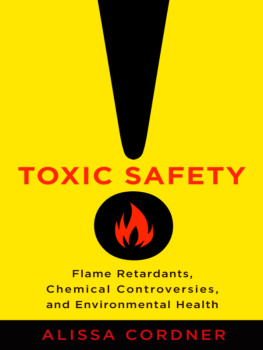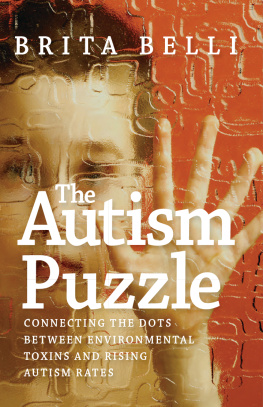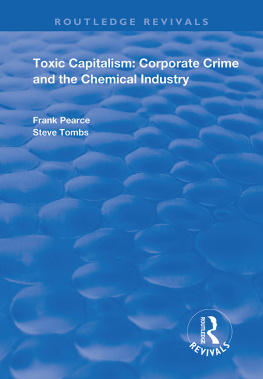Table of Contents
TOXIC SAFETY
ALISSA CORDNER
TOXIC SAFETY
Flame Retardants, Chemical Controversies, and Environmental Health
COLUMBIA UNIVERSITY PRESS NEW YORK
Columbia University Press
Publishers Since 1893
cup.columbia.edu
New York Chichester, West Sussex
Copyright 2016 Columbia University Press
All rights reserved
E-ISBN 978-0-231-54138-1
Library of Congress Cataloging-in-Publication Data
Cordner, Alissa.
Toxic safety : flame retardants, chemical controversies, and environmental health / Dr. Alissa Cordner.
pages cm
Includes bibliographical references and index.
ISBN 978-0-231-17146-5 (cloth)ISBN 978-0-231-17147-2 (pbk.)978-0-231-54138-1 (e-book)
1. Fireproofing agentsEnvironmental aspects. 2. Fireproofing agentsToxicology. I. Title.
TD428.F57C67 2016
363.1791dc23
2015024698
A Columbia University Press E-book.
CUP would be pleased to hear about your reading experience with this e-book at .
Cover design: Diane Lugar
References to Internet websites (URLs) were accurate at the time of writing. Neither the author nor Columbia University Press is responsible for URLs that may have expired or changed since the manuscript was prepared.
CONTENTS
I am deeply indebted to many people who have helped me conduct my research, develop these arguments, and complete this book.
First, my deepest thanks to all those whom I interviewed and spent time with over the course of my research, especially those at FlameCorp, the EPAs Design for the Environment Program, the EPAs Environmental Public Health Division, an unnamed environmental health organization, and an unnamed academic chemistry laboratory. People at each of these institutions welcomed me and answered innumerable questions. Though I do not identify individuals by name, I hope they all find their words and actions to be accurately portrayed.
I have benefited immensely from wonderful academic mentors. Many thanks to Phil Brown, who has endlessly encouraged and guided my research. I could not ask for a more supportive mentor or a better role model of how to conduct environmental health research that makes a difference. Timmons Roberts provided invaluable suggestions throughout my research and writing process, directing me to important empirical insights. Nitsan Chorev encouraged me to consider new and more significant theoretical implications. Gianpaolo Baiocchi was a constant support, through this research and through the other Project that dominated my intellectual life for the past several years.
Others have supported my work in various ways. The Contested Illnesses Research Group at Brown University provided a nurturing space for developing ideas, rewriting proposals, and revising chapters, as did the Social Science Environmental Health Research Institute at Northeastern University. Special thanks go to David Ciplet for reading drafts and providing feedback, and to Mercedes Lyson and Margaret Mulcahy for the interviews and research they conducted on the larger flame retardant project. Margot Jackson and Dennis Hogan provided insightful comments and clear suggestions for next steps. Susan E. Bell and Nancy Riley influenced my work as an undergraduate student, and I feel fortunate to count them as colleagues years later. My deep appreciation also goes to Rebecca Gasior Altman, Catherine Bliss, Rachel Morello-Frosch, Ruthann Rudel, and Sara Shostak for offering feedback, ideas, and support throughout my research and writing process.
I am extremely grateful for the collaborative environment at Whitman College. I have been lucky to count Bill Bogard, Keith Farrington, David Hutson, Michelle Janning, Helen Kim, and Gilbert Mireles as departmental colleagues. Thank you for your support of my work at Whitman and for our sociology writing group. Laura Ferguson, Adam Gordon, Emily Jones, and Lisa Uddin shared excellent feedback and good food during our summer writing group. Helen Kim and Lydia McDermott organized wonderful writing retreats where many of these pages were written or revised.
Innumerable thanks go to Laura Ferguson for Bennington runs, Sarah Koenigsberg for climbing and Burwood, Jen Cohen for trivia night, and Bridger for tennis ball time. Thank you for your friendship and encouragement. I am so lucky to count Elizabeth A. Bennett, Peter T. Klein, Erica Jade Mullen, Mim Plavin-Masterman, Stephanie Savell, Trina Vithayathil, and Mujun Zhou as dear friends and colleagues. Extra thanks to Trina, Chris, Markose, and Mathia; Pete and Steph; Dave, Jenn, Eliza, Cora, and Marlon; and Meghan Kallman for great visits to Providence while I lived all over the country. Elizabeth A. Bennett, how amazing that we both ended up in the Northwest. Thanks to you, Ben Falk, Dalva, and Rhubarb for being the best. Mandy Marvin, thank you for reminding me to seek out spontaneous fun every day. Adrian Velasco, thank you for the wild adventures we had together.
My research was supported by the EPA STAR Fellowship program (FP 917119). Additional work on the social implications of flame retardants, including some of the interviews I conducted for this project, was also funded by NSF (SES-0924241). This work has not been reviewed by the EPA or NSF, and does not reflect EPA or NSF policy in any way. I also received funding from Whitman Colleges Professional Development Account, the American Sociological Association, Brown Universitys Graduate School, and the Brown University International Affairs Travel Fund for research expenses and conference travel. I would also like to thank Chemical-Watch, the Environmental Law Institute, and the Fire Safety Bulletin for providing free or reduced-cost access to useful resources. Parts of
I was fortunate to work with Kathryn Schell at Columbia University Press, who was endlessly supportive of this project. Thanks to Patrick Fitzgerald and Phil Brown for making that connection, and to Lyndee Stalter and Vickie West for their help during copy editing and production. The comments of two anonymous reviewers have deeply strengthened this final book. Thank you to Jane Henderson for a beautiful index, and for being such a close family friend all these years.
Finally, my greatest thanks and love to my family. Susanne Cordner, I treasure what our sisterhood has become these last few years. I am so proud of you and excited for your next steps. Extra thanks for your help with 1980s legal decisions! Barbara Tyler, thank you for being a role model of strength and kindness, and for being the first sociologist in the family. And endless thanks to Ian Cordner and Virginia Tyler for a lifetime of love and support, and for teaching me the value of making a difference. Without my family, I would never have started on this path, let alone have ended up at this next juncture.
| ACC | American Chemistry Council |
| BFR | brominated flame retardant |
| BPA | bisphenol-A |
| BSEF | Bromine Science and Environmental Forum |
| CBI | confidential business information |
| CfFS | Citizens for Fire Safety |
| CPSC | Consumer Product Safety Commission |
| DBDPEthane | decabromodiphenyl ethane |







